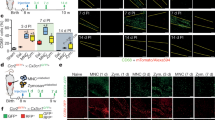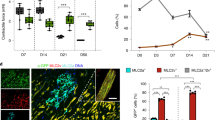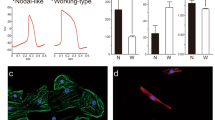Abstract
Simple ex vivo or in vitro models are most useful for testing putative cell therapy protocols, as they allow quick and controlled screening of variants and possible improvements. We discuss here three different models: coculture of precursors of human bone marrow cells (BMCs) with mouse heart slices bearing a cryogenic lesion; coculture of human BMCs and rat cardiomyocytes separated by a porous membrane that allows passage of soluble substances but prevents migration of nuclear material; and injection of human BMCs in developing chick heart bearing burn lesions. Our results indicate that the damaged areas express specific genes such as MPC1 and SDF1, and that some human BMCs migrate and graft near the lesion, where they can originate cells with a cardiac phenotype that produce human cardiac proteins. The frequency of this transformation is, however, very low. Understanding the factors that determine and regulate nuclear reprogramming and transdifferentiation would be crucial to appraising the contribution of these phenomena to cardiac regeneration and, eventually, to modulating them with therapeutic intent.
This is a preview of subscription content, access via your institution
Access options
Subscribe to this journal
Receive 12 print issues and online access
$209.00 per year
only $17.42 per issue
Buy this article
- Purchase on Springer Link
- Instant access to full article PDF
Prices may be subject to local taxes which are calculated during checkout


Similar content being viewed by others
References
Anversa P and Nadal-Ginard B (2002) Myocyte renewal and ventricular remodelling. Nature 415: 240–243
Orlic D et al. (2001) Bone marrow cells regenerate infarcted myocardium. Nature 410: 701–705
Kajstura J et al. (2005) Bone marrow cells differentiate in cardiac cell lineages after infarction independently of cell fusion. Circ Res. 96: 127–137
Strauer BE et al. (200) Repair of infarcted myocardium by autologous intracoronary mononuclear bone marrow cell transplantation in humans. Circulation 106: 1913–1918
Assmus B et al. (2002) Transplantation of progenitor cells and regeneration enhancement in acute myocardial infarction (TOPCARE-AMI). Circulation 106: 3009–3017
Stamm C et al. (2003) Autologous bone-marrow stem-cell transplantation for myocardial regeneration. Lancet 361: 45–46
Saito T et al. (2003) Transcoronary implantation of bone marrow stromal cells ameliorates cardiac function after myocardial infarction. J Thorac Cardiovasc Surg 126: 114–123
Badorff C et al. (2003) Transdifferentiation of blood-derived human adult endothelial progenitor cells into functionally active cardiomyocytes. Circulation 107: 1024–1032
Tse HF et al. (2003) Angiogenesis in ischaemic myocardium by intramyocardial autologous bone marrow mononuclear cell implantation. Lancet 361: 47–49
Perin EC et al. (2003) Transendocardial, autologous bone marrow cell transplantation for severe, chronic ischemic heart failure. Circulation 107: 2294–2302
Fuchs S et al. (2003) Catheter-based autologous bone marrow myocardial injection in no-option patients with advanced coronary artery disease: a feasibility study. J Am Coll Cardiol 41: 1721–1724
Fernández-Avilés F et al. (2004) Experimental and clinical regenerative capability of human bone marrow cells after myocardial infarction. Circ Res 95: 742–748
Wollert KC et al. (2004) Intracoronary autologous bone marrow cell transfer after myocardial infarction: the BOOST randomised controlled clinical trial. Lancet 364: 141–148
Lange C et al. (2005) High-potential human mesenchymal stem cells. Stem Cells Dev 14: 70–80
Herzog EL et al. (2003) Plasticity of marrow-derived stem cells. Blood 102: 3483–3493
Zuk PA et al. (2002) Human adipose tissue is a source of multipotent stem cells. Mol Biol Cell 13: 4279–4295
Thomas SP et al. (2000) Synthetic strands of neonatal mouse cardiac myocytes: structural and electrophysiological properties. Circ Res 87: 467–473
Kehat I et al. (2001) Human embryonic stem cells can differentiate into myocytes with structural and functional properties of cardiomyocytes. J Clin Invest 108: 407–414
Abbott JD et al. (2004) Stromal cell-derived factor-1alpha plays a critical role in stem cell recruitment to the heart after myocardial infarction but is not sufficient to induce homing in the absence of injury. Circulation 110: 3300–3305
Ma J et al. (2005) Time course of myocardial stromal cell-derived factor 1 expression and beneficial effects of intravenously administered bone marrow stem cells in rats with experimental myocardial infarction. Basic Res Cardiol 100: 217–223
Limbourg FP, Drexler H. (2005) Bone marrow cells for myocardial infarction. Effect or mediator? Circ Res 96: 6–8
Acknowledgements
Support from Fondo de Investigaciones Sanitarias de la Seguridad Social, grant PI-041486, Fundación de Investigación Médica de la Mutua Madrileña and Red de Terapia Celular del Instituto de Salud Carlos III is gratefully acknowledged.
Author information
Authors and Affiliations
Corresponding author
Ethics declarations
Competing interests
The authors declare no competing financial interests.
Rights and permissions
About this article
Cite this article
Sánchez, A., Fernández, M., Rodríguez, A. et al. Experimental models for cardiac regeneration. Nat Rev Cardiol 3 (Suppl 1), S29–S32 (2006). https://doi.org/10.1038/ncpcardio0458
Received:
Accepted:
Issue Date:
DOI: https://doi.org/10.1038/ncpcardio0458
This article is cited by
-
Cardiac Transcription Factors Driven Lineage-Specification of Adult Stem Cells
Journal of Cardiovascular Translational Research (2010)
-
Cardiac repair by stem cells
Cell Death & Differentiation (2007)



